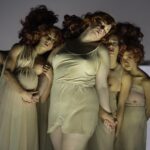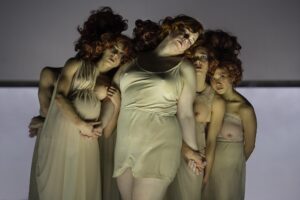
by Heather Cassell
There is something about Georgia, Georgia O’Keeffe that is, that has kept people following her art work and seeking her out in the places she lived and created throughout her life nearly 30 years after her death at the ripe age of 98.
I am only one of many who during a recent trip to New Mexico stood in the same spots the late Georgia once did and examined her face, one of a life well lived, deeply lived, taken by famed photographer and her husband Alfred Stieglitz.
I’ve only dabbled in knowing Georgia, who was notoriously known for being a very private woman. Like a good feminist and independent woman in my own right, I own an obligatory poster of one of her works from the San Francisco Museum of Modern Art. I watched the biographical movie, simply titled with her name, Georgia O’Keeffe, starring Joan Allen and Jeremy Irons, who portrayed Georgia and her mentor-turned-husband Alfred, respectively, on the Lifetime, the channel for women.
Alfred essentially brought photography into the sphere of being considered an art form in the early days of photography and film and was a key figure promoting some of the 20th century’s most well-known artists and photographers at his various galleries in New York.
I am not a drawer or painter. I can barely get past my own cave drawings, hand gestures and the sound of my own voice as I attempt to describe what I see in my head to a true artist. I love photography, but I still haven’t grasped what the numbers and combinations together do to create the image I want when I flip the switch from auto mode to manual mode, unlike Super G where machines and technology are second nature to her. My craft is telling stories of people, events, places and things on the page.

After this journey to New Mexico I still can’t draw or paint, nor did I attempt to (however I will continue to attempt to master the camera), and I still don’t know Georgia. Not after walking in the same dirt she traversed; standing in the same spot she stood; seeing the same majestic models of snowcapped mountains with the deep crevices lit up by the sun and shadows cast by the clouds and the vast red and clay brown earth sparsely covered with sage and tumble weed. It was these landscapes and the objects within them that she transformed into a vision on canvas. And not after visiting the Georgia O’Keeffe Museum (217 Johnson Street; 505-946-1000; OKeeffeMuseum.org) in Santa Fe. It was simply enough for me to be there breathing the same crisp air and enjoying the same creative spirit.
To be in the presence of that creative, independent spirit was really why I was tracing Georgia’s footsteps during my recent sojourn to New Mexico, the land that claimed Georgia as its own. It wasn’t really to get to know her better, but to simply take in the creative spirit of Northern New Mexico by visiting one of the many places that she was so comfortable exploring and bringing its beauty to the public’s attention throughout the 20th century.
Following Georgia, my girlfriend and I, flew into Albuquerque and drove directly to Taos with the plan to make our way back through Santa Fe to Albuquerque. Our flight was delayed out of San Francisco, so we weren’t able to take the High Road between Santa Fe and Taos, as suggested.
We arrived late in the night at Casa Gallina (613 Callejon Road; 575-758-2306; CasaGallina.net), where we were guests of this charming casita for the next two days.
Awaking the next morning we began our daylong expedition to the sites where Georgia once set up her easel and mixed the colors on her palette.
Our guide in Taos was artist Robert Cafazzo. Robert owns Two Graces Plaza Gallery (68 St. Francis Plaza; 575-758-4101; TwoGraces.com) with his wife, artist Holly Sievers, which is located at the opening of the plaza where San Francisco De Asis Church (60 St Francis Plaza; 575-758-2754; www.nps.gov/history/nr/travel/american_latino_heritage/San_Francisco_de_Assisi_Mission_Church.html) stands. The adobe church immortalized by Georgia, literally, because in June the annual event to re-mud/re-surface the outside walls of the church begins. The ritual called, “Ejarre,” brings together Taoseans who volunteer for two to six weeks to reapply the adobe, a mixture of the local earth mixed with straw and water, says Robert.
This year, the annual ritual was captured by documentary filmmaker and photographer Mary Anne Bruni, for a future documentary about the process, Robert tells Girls That Roam.

On the trail of Georgia, we strolled through the famed Mabel Dodge Luhan House (240 Morada Lane; 575-751-9686; MabelDodgeLuHan.com). The historic artist retreat where for decades creative, political and intellectual leaders of the day, such as Georgia, Willa Cather, Ansel Adams, Elsie Clews Parsons, Ella Young and many others, converged inspiring each other over dinner before returning to their respective rooms or destinations to create. The late actor Dennis Hopper continued the tradition with his generation of artists and intellectuals when he owned the house. Today, guests can take an artists’ retreat at the house or they can find inspiration at the Sagebrush Inn and Suites (1508 Paseo Del Pueblo Sur; 575-758-2254; ; SagebrushInn.com), where Georgia also stayed and painted.
In Georgia’s day, if she was staying at the Mabel Dodge Luhan House, she would have walked across the rocky gully to La Morada de Nuestra Señora de Guadalupe Don Fernando de Taos, commonly called the Taos Morada, where it is believed that she created her 1929 painting, “Black Cross, New Mexico.”
The Taos Morada is a simple church built by the Toasean Penitentes, Roman Catholics when they were without a priest or church, in 1860. The church is now maintained by the parish of Our Lady of Guadalupe. Behind the church is what is now known as O’Keeffe’s “Black Cross.”
While the world may know it as the black cross that Georgia painted, it is also a sacred place that Toaseans along with visitors seek out. In an annual ritual, the town gather on Good Friday for a six mile procession starting at San Francisco De Asis Church to three moradas, including Toas Morada, ending at the Santurio de Chimayo (15 Santuario Drive, Chimayo; 505-351-9961; ElSantuarioDeChimayo.us), Robert tells us.
Taos is a true artist and intellectual getaway, not necessarily for relaxation, but for the convergence of the thought leaders of yeasteryear and even today to inspire each other and create. Robert mentioned that one of the heads of search engine giant Google is among the celebrities, such as Julia Roberts, that own a home in Taos.

A Life Lived
Walking in the path of Georgia ended, for me, in Santa Fe at the Georgia O’Keeffe Museum where I saw the “Georgia O’Keeffe and Ansel Adams: The Hawai’i Pictures” exhibit. Hawaii’s nature and people is intently studied and vividly captured in Georgia’s paintings and Ansel’s photographs. The exhibit featuring Georgia and Ansel’s exploration of Hawaii in painting and photography first opened last year at the Honolulu Museum of Art.
You can learn more about Georgia’s experience in Hawaii in Georgia O’Keeffe’s Hawai’i.
The Hawaii and Abiquiu exhibits are currently showing through September 14.
Also on display is “Georgia O’Keeffe’s Abiquiu Views,” a view from Georgia’s studio at Abiquiu with her tools and notes about her patterns of how she worked.
I didn’t make it out to Abiquiu to tour Georgia’s home and studio, but limited tours are available through the museum and the Abiquiu Inn (21120 Highway 84; 505-685-4539; AbiquiuInn.com).
Finally, works from watercolors to sketches to oil paintings and Alfred’s many portraits of Georgia on display for visitors to enjoy.
To book your journey to Georgia’s New Mexico, contact Heather Cassell at Girls That Roam Travel at Travel Advisors of Los Gatos at 408-354-6531at or .
To contract an original article, purchase reprints or become a media partner, contact ">editor [@] girlsthatroam [.] com.







